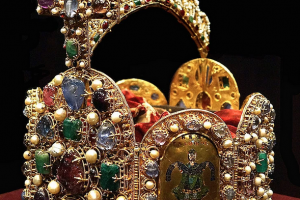With war threatening the French empire, Napoleon backed off from dealing with the pope for awhile. At this point other matters occupied his mind, such as securing the crown of the Holy Roman Empire for himself. Pictured to the left (or above), the crown of the once-mighty Holy Roman Empire was in use from the 11th century until the empire’s dissolution in 1806.
Prussia was growing restless. The Prussian leader, King Friedrich Wilhelm III, had discovered that betraying the Russians and the Austrians had not paid off, and Napoleon’s growing power was now extending into lands that Prussia wished to dominate—namely, the numerous duchies, principalities and kingdoms of the Holy Roman Empire.
Since his rise to power, Napoleon had seized several German imperial lands. He had made German territories west of the Rhine part of France. He had taken Hanover from King George III of Great Britain. He had made the kingdoms of Württemberg and Bavaria his allies. And, now, in July 1806, he threatened to force most of Germany to acknowledge his overlordship.
Napoleon was able to convince Bavaria, Württemberg, Baden, Hesse, Cleves, Berg, and 10 other German states to enter into an alliance with him. On July 12, 1806, these 16 states signed the Treaty of the Confederation of the Rhine, in which they formally left the Holy Roman Empire and proclaimed Napoleon their “protector.” The Confederation was to be a loose union in which each state kept its sovereignty, but all were joined together, primarily to support each other in war. As part of the treaty, each state was to supply troops to Napoleon’s army.
The Confederation of the Rhine was a direct violation of Franz II’s rights as Holy Roman Emperor.

As emperor, of course, Franz II held no real power over most of the German imperial states. Yet, the title of Roman Emperor still had prestige. It was ancient and venerable, evoking memories of the medieval ideal of Christendom, where pope and emperor united all Christian nations into a common society.
Since the fall of the Roman Emperor of the west in the year 476, the Byzantines, Charlemagne, the German kings, and the Russian tsars had all claimed the imperial title. The Church herself had revived it in the west. Even King Henry VIII of England and French kings had sought to obtain it. And now, at the dawn of the 19th century, Napoleon Bonaparte coveted it. He wanted be the Roman Emperor, uniting all Europe under his mighty sway.
Yet as Pope Pius VII had reminded Napoleon earlier, the imperial title belonged to the Habsburgs. This vexed Napoleon. After all, had he not defeated the reigning Roman Emperor, Franz II, many times in battle and forced him to surrender vast territories? How could Napoleon tolerate the lesser man holding the greater honor?
Franz II understood Napoleon’s ambitions.
The Confederation of the Rhine, Franz II knew, meant only one thing—that the title of Roman Emperor would eventually pass from the Habsburgs to Bonaparte.
To prevent this transfer of power to Napoleon, on August 6, 1806, Franz II formally dissolved the Holy Roman Empire. From then on, he would be simply Franz I, First Emperor of Austria.
The empire of Christendom—the Holy Roman Empire—over which Franz had ruled, a realm whose history reached back to the coronation of Charlemagne a thousand years before, had come to a sad but quiet end.
Another Failure in 1806
Ludwig van Beethoven wrote his Concerto for Violin in D Major for the violinist Franz Clement. Clement premiered the piece in December 1806 at the Theater an der Wien, Vienna. It was not a success. It has been said that Beethoven (as was his habit) finished the music too late for Clement to learn it sufficiently well.
The concerto was not performed again until 1844, when it was revived by the violinist Joseph Joachim. It has since become one of the most famous of violin concertos. This same Beethoven concerto, linked below, is by the great Russian violinist, David Oistrakh, and the Moscow Philharmonic, conducted by Kirill Kondrashin.
—————————–
This text, slightly edited for accommodation in the Catholic Business Journal, comes from Catholic Textbook Project’s history textbook, Light to the Nations II: The Making of the Modern World.



You must be logged in to post a comment.